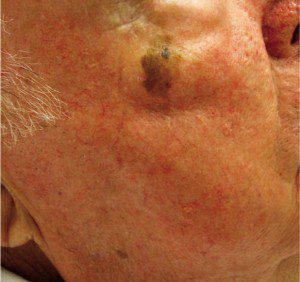 When physicians discuss skin cancer, it’s melanoma that worries us. Melanoma or malignant melanoma as it is sometimes called is a cancer of the melanocytes, pigment producing cells in the basal layer of the skin. Melanoma accounts for less than 5% of all skin cancers but is responsible for over 90% of deaths caused by skin cancer. One person dies of melanoma every hour and it is the most common form of cancer in young adults 25-29 years old.
When physicians discuss skin cancer, it’s melanoma that worries us. Melanoma or malignant melanoma as it is sometimes called is a cancer of the melanocytes, pigment producing cells in the basal layer of the skin. Melanoma accounts for less than 5% of all skin cancers but is responsible for over 90% of deaths caused by skin cancer. One person dies of melanoma every hour and it is the most common form of cancer in young adults 25-29 years old.
The development of a melanoma is linked to ultraviolet (UV) radiation from the sun. UV radiation causes a mutation in the DNA of melanocytes causing uncontrolled growth of new cancer cells. The presence of pigment in the skin helps block the UV radiation so fair skinned people are at a much higher risk of melanoma. The incidence of melanoma is increasing, possibly due to breakdown of the ozone layer.
Melanoma commonly develops in a previously existing benign skin lesion. Signs of melanoma have been described as the ABC’s.
Asymmetry – If a line is drawn through a lesion dividing it in two, in a melanoma one half may not look like a mirror image of the other half.
Border – The edges of a melanoma may be irregular, jagged.
Color – A melanoma can be pigmented with black, purple, brown, red parts.
Diameter – We get more concerned with skin lesions larger than the size of a pencil eraser.
Evolving – A lesion that is growing or changing colors makes us suspicious that it may be a melanoma.
If a lesion is thought to be a possible melanoma, it should be removed surgically. If a portion is being removed for biopsy, it is important that the full thickness of the lesion be preserved. Unlike other skin cancers, the top of a melanoma should not be shaved off for diagnosis.
Like the diagnosis, treatment of melanoma is primarily surgical. If a lesion is found to be a melanoma, a second, wide excision with 1-2 cm of normal skin all around the melanoma should be removed, depending on the depth of the melanoma in the layers of the skin. That depth of invasion helps determine the likelihood that the melanoma has spread to nearby lymph nodes. In some cases local lymph nodes are removed to be checked for cancer. If lymph nodes are involved, chemotherapy would be used. Recent advances have led to the development of drugs that target proteins in a melanoma resulting in effective shrinking of tumors with less toxicity and side effects. Ultimately the prognosis of a melanoma patient is tied to the depth of the melanoma.
Minimizing exposure to UV radiation is the key to prevention.
- limit sun exposure during peak hours (10am-2pm)
- use sunscreen of 30SPF or higher and reapply often
- wear broad brimmed hats and tightly woven protective clothing
- annual skin exam
A person’s risk of developing melanoma doubles if he or she has had more than 5 sunburns or 1 or more blistering sunburns as a child or adolescent. Regular use of SPF 15 or higher sunscreen reduces the risk of developing melanoma by 50%. Hopefully through prevention we will reduce the incidence of melanoma.
Bradenton Skin Cancer
250 2nd Street E., Suite 4C
Bradenton, FL 34208
941-744-5860






